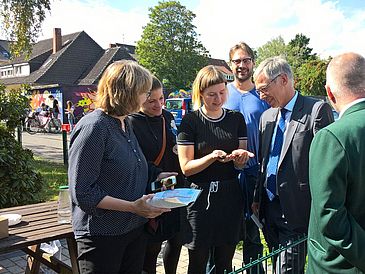An excerpt from the texts: The prisoners get up at 5:30 a.m. There’s no breakfast. They walk in rows of five from the meeting point to the harbor. Soldiers and members of the SS keep a sharp eye on them. 700 men walk in the evenings and mornings. The report of a Belgian survivor makes it clear how weak they must have been: “At noon we had soup – water with kohlrabi and turnip pieces.” And a former shipyard worker remembers: “They were so weak that even a little boy could knock them over.”
Conversations with Contemporary Witnesses
The intensive examination of the history of Schützenhof, a satellite camp of the Neuengamme concentration camp, began at the University of Bremen with geophysical measurements and excavations of foundations under the direction of Bremen state archaeologist Professor Uta Halle. In a parallel seminar by Dr. Ulrike Huhn from the Research Centre for East European Studies, six students from the History and Integrated European Studies degree courses researched material on the camp in the Bremen state archives and in the archive of the Neuengamme Concentration Camp Memorial. They talked to contemporary witnesses and their relatives. The audio walk is the result of the joint work of Jan Dohrmann, Lilja Girgensohn, Anna Görner, Lennart Pohl, Johanna Sachse, and Julia Szarzech.
Use in Arms Production
During the Second World War, A.G. Weser was intensively involved in arms production. In the final months of the war, concentration camp prisoners were to compensate for the significant shortage of labor. For a few months, from December 1944 to the end of March 1945, a satellite camp of the Neuengamme concentration camp near Hamburg existed on the grounds of the Schützenhof in Bromberger Strasse. Around 700 men were imprisoned here, yet the names of just 257 people who did not survive the camp or the forced labor at A.G. Weser are known.
Many Helpers and Supporters
The audio walk vividly depicts people’s living conditions and illuminates historical backgrounds. The walker is guided by GPS through Gröpelingen and hears professionally recorded scenes and noises again and again. The texts were recorded by Bremen actors Andrea zum Felde and Christian Bergmann. “We had a lot of helpers,” says Johanna Sachse, one of the participants. She first names the Gröpelingen Geschichtswerkstatt (historical workshop) and the past-at-present company from Berlin, which specializes in teaching history through various forms of multimedia. “In our research, we also benefited from the expertise of Karsten Ellebrecht, who has been researching forced labor in Bremen for a long time.” The retired teacher supported the student’s research in the Bremen state archives. In the military archives in the French town of Caen, he also found a sketch of the Schützenhof satellite camp that a former prisoner had perhaps made afterwards. “This find once again illustrates the dimension of how international the history of the Bremen camp actually is and how traces of a camp that ultimately only existed for a few months can still be found abroad,” says Johanna Sachse.
Footpath to A.G. Weser
The digital walk starts with the free Radio Aporee app, which is available in the App Store or on Google Play, at Schützenhof in Bromberger Str. 117 and follows the prisoners’ daily route to the former A.G. Weser factory premises at the harbor. From there the route leads along the Waterfront and ends at the bunker on Pastorenweg. A total of 5.5 kilometers will be covered.
Additional Information:
https://einkzfuerdiewerft.wordpress.com/audiowalk
www.landesarchaeologie.bremen.de/presse-1477
Contact:
Dr. Ulrike Huhn
Research Centre for East European Studies
University of Bremen
Tel.: +49 421 218-69611
E-mail: ulrike.huhn@uni-bremen.de

